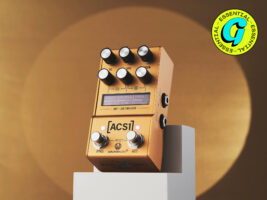
Walrus Audio Mako Series MkII ACS1 review: “this is as good as digital amp and cab simulators get”
$449/£419, walrusaudio.com
The great thing about amp simulators is that they offer three different ways to fall out with someone in a raging, expletive-strewn argument. First up, there’s the straightforward debate about which one is best. Then there’s the wider philosophical dichotomy between digital and analogue types. And finally, the question with real brawling-in-the-street potential: are any of these products actually up to the job, or are they just soulless imitations of the real thing?
READ MORE: Walrus Audio Mako Series MkII D1 review – the do-it-all high-fidelity delay pedal gets glitchy
None of these arguments will ever end. But the Walrus Audio Mako Series MkII ACS1 surely makes the most persuasive case yet for using a digital pedal to replace real amps and cabs when it comes to gigging, recording and even bedroom practice with headphones.
Image: Adam Gasson
What is the Walrus Audio Mako Series MkII ACS1?
The main point of a pedal like this one is to cut a whole load of bulk (and noise) out of your rig: plug a guitar in at one end, and what comes out of the other is a digital simulation of what you’d get from putting a microphone in front of a real-life amp and speaker cabinet. Send that straight to an audio interface or live PA, and hey presto: all that heavy hardware in your spare room is suddenly ready to be converted into novelty coffee tables.
The original ACS1 offered three amp types and six cabinet IRs, with full stereo capability, onboard room reverb and the ability to store three presets (or 128 with MIDI). MkII brings revised versions of the old unit’s Fender Deluxe Reverb, Marshall Bluesbreaker and Vox AC30 models, and adds an Orange Rockerverb, a Mesa Boogie Dual Rectifier and a Peavey 5150 – while expanding the cab offering to 12. You also get a choice between room, hall and spring reverbs, and no less than nine preset slots.
How is all of this possible? As discussed in my review of the MkII D1 delay, the whole Mako Series has had an interface revamp, with an LED display replacing the three toggle switches across the middle. Here’s where, with the help of the three encoder knobs above it, you get access to those extra settings and a few more besides (including an option to bypass the IRs). It might not feel super-intuitive at first, but the whole system is clear and logical.
Image: Adam Gasson
What does the Walrus Audio Mako Series MkII ACS1 sound like?
I don’t have a lot to say about the clean tones. They were already lusciously lifelike and three-dimensional, and now they’re still lusciously lifelike and three-dimensional but with a bit more headroom – the main effect of which is that, when you hit the boost switch, it actually makes things bigger and louder rather than just getting thick and congested. You can also adjust the boost level for each preset, which is very handy.
The Vox crunch still lacks midrange punch out of the box, but you can fix this quite satisfyingly by cranking the mids to maximum in the three-band EQ. And if you really want to rock like a mudskipper? The overdriven Orange, Boogie and Peavey models all sound impressively large when used one at a time – and simply colossal in stereo pairs.
To experience that colossalness to the full, you might be inclined to leave at least some of the factory presets unchanged (aside from dialling back the reverb and maybe turning off the annoying noise gate). While the first two batches of three presets cover the six single models, the last set offers absolutely killer left/right pairings: Fender and Vox, Marshall and Orange, then Peavey and Boogie. This last setup, fully panned, is probably the biggest guitar sound my home studio monitors have ever spewed out.
Image: Adam Gasson
Should I buy the Walrus Audio Mako Series MkII ACS1?
Here’s one more argument to enjoy: Are the MkII ACS1’s Vox tones as convincing as those of the Strymon Iridium? For me that’s too close to call, but in every other respect there’s no contest, because this is as good as digital amp and cab simulators get – and the step up to MkII has turned an already great pedal into an utterly compelling one.
Walrus Audio Mako Series MkII ACS1 alternatives
The aforementioned Strymon Iridium (£379) is now six years old and surely due some kind of update. A newer rival with cab models galore is the Boss IR-200 (£329), while analogue purists might prefer the DSM & Humboldt Simplifier X (£449).
The post Walrus Audio Mako Series MkII ACS1 review: “this is as good as digital amp and cab simulators get” appeared first on Guitar.com | All Things Guitar.
Source: www.guitar-bass.net












